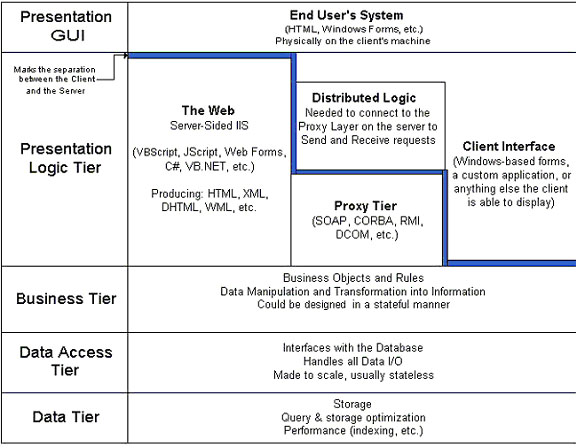| THE MICROSOFT .NET FRAMEWORK |
The .NET Framework is the infrastructure for the Microsoft .NET platform. The .NET Framework is an environment for building, deploying, and running Web applications and Web Services. |
| The .NET Framework has two main components : |
|
|
+ |
The common language runtime is the foundation of the .NET Framework. |
| .NET Framework class library. |
+ |
The .NET Framework class library is a collection of reusable types that tightly integrate with the common language runtime. The class library is object oriented, providing types from which your own managed code can derive functionality. In addition, third-party components can integrate seamlessly with classes in the .NET Framework.
vices. |
|
|
|
| Tier Architecture concept: |
* |
Client-Server architecture is 2-Tier architecture because the client does not distinguish between Presentation layer and business layer. |
* |
Layered architectures are essentially objects and work in object-oriented environments, such as ASP.NET. ASP.NET supports layered architecture |
* |
In software engineering, multi-tier architecture (often referred to as n-tier architecture) is a client-server architecture in which, the presentation, the application processing and the data management are logically separate processes The most widespread use of "multi-tier architecture" refers to three-tier architecture. |
* |
The concepts of layer and tier are often used interchangeably. a layer is a logical structuring mechanism for the elements that make up the software solution, while a tier is a physical structuring mechanism for the system infrastructure. |
| |
|
Three-tier Architecture |
* |
A three-tier architecture introduces a server (or an "agent") between the client and the server. |
* |
'Three-tier' is a client-server architecture in which the user interface, functional process logic ("business rules"), computer data storage and data access are developed and maintained as independent modules, most often on separate platforms. |
* |
The three-tier model is considered to be a software architecture and a software design pattern. |
| |
The 3-Tier architecture has the following three tiers: |
| |
Presentation Tier |
| |
This is the topmost level of the application. The presentation tier displays information related to such services as browsing merchandise, purchasing, and shopping cart contents. It communicates with other tiers by outputting results to the browser/client tier and all other tiers in the network. |
| |
Application Tier (Business Logic/Logic Tier) |
| |
The logic tier is pulled out from the presentation tier and, as its own layer, it controls an application’s functionality by performing detailed processing. |
| |
Data Tier |
| |
This tier consists of Database Servers. Here information is stored and retrieved. This tier keeps data neutral and independent from application servers or business logic. Giving data its own tier also improves scalability and performance. |
| |
The data layer’s responsibility is to communicate with the backend structure, such as a database. The business layer is responsible for validating the business rules of the component, and communicating with the data layer. |
| |
The business and data layer retrieve or update the data in a database for an ASP.NET application. |
A special type of client/server architecture consisting of three well-defined and separate processes, each running on a different platform: |
1. |
The user interface, which runs on the user's computer (the client). |
2. |
The functional modules that actually process data. This middle tier runs on a server and is often called the application server. |
3. |
A database management system (DBMS) that stores the data required by the middle tier. This tier runs on a second server called the database server. |
| The three-tier design has many advantages over traditional two-tier or single-tier designs, the chief ones being: |
> |
The added modularity makes it easier to modify or replace one tier without affecting the other tiers. |
> |
Separating the application functions from the database functions makes it easier to implement load balancing. |
| These are some of the advantages of three-tier architecture: |
> |
It is easier to modify or replace any tier without affecting the other tiers. |
> |
Separating the application and database functionality means better load balancing. |
> |
Adequate security policies can be enforced within the server tiers without hindering the clients. |
| |
|
Four-tier |
| The 4-Tiers are, |
1. |
Business Object [BO] |
2. |
Business Access Layer [BAL] |
3. |
Data Access Layer [DAL] |
4. |
UI (4-Tier) folder [UI] |
| N-tier |
N-Tier the word means Multiple Tier. Usually N-Tier Architecture begins as a 3-Tier model and is expanded. |
N-tier application architecture provides a model for developers to create a flexible and reusable application |
N-Tier architecture refers to the architecture of an application that has at least 3 "logical" layers -- or parts -- that are separate. Each layer interacts with only the layer directly below, and has specific function that it is responsible for. |
N-Tier Architecture is nothing but splitting your solution into different project based on the business requirement. |
Each layer can be located on physically different servers with only minor code changes, hence they scale out and handle more server load. Also, what each layer does internally is completely hidden to other layers and this makes it possible to change or update one layer without recompiling or modifying other layers. |
This is a very powerful feature of n-Tier architecture, as additional features or change to a layer can be done without redeploying the whole application. |
Advantage: |
> |
Reduce the business and the programming complexity. |
> |
Easy to process |
In the term "N-tier," "N" implies any number -- like 2-tier, or 4-tier; basically, any number of distinct tiers used in your architecture. Application architectures are part of Layer 7 of the OSI model. |
|
|
|
| |
 |
| |
|




